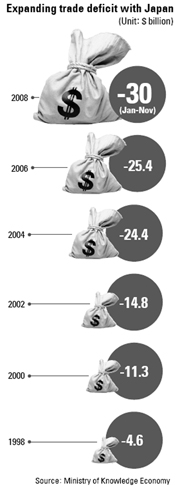Why is the trade deficit with Japan growing?

Goods head from Japan to Korea.[JoongAng Ilbo]
In the last two months, Korea has seen its overall trade situation turn around. During this period, Korea has made more money shipping its products overseas than it paid for imports.
This means that it has posted a surplus in its trade balance, which it had failed to do for four months until October.
Last month’s balance recorded a surplus of $2.9 million. In October the surplus was much larger, at $1.2 billion.
However, Korea’s trade balance with Japan has seen an ever-growing deficit.

As of last month, the trade deficit with Japan had already exceeded $30.3 billion for the year.
This is a new record for trade with Japan, displacing last year’s record of $29.8 billion.
Additionally, the deficit with Japan is the largest among all the countries that trade with Korea.
Ever since we established trade relations with Japan in 1965, Korea has been seeing a deficit. As of last year, the cumulative amount over four decades was $311.1 billion in Japan’s favor.
The size of the deficit has been expanding rapidly, especially since 2001.
The biggest reason is that Korea imports a large amount of products from Japan.
Imports from the country have been growing steadily since 2001, when the country began to open its doors wider to Japanese goods.
Before 2001, some goods including movies, music and animated films were restricted by the Korean government.
To enhance the relationship between the two countries, the Korean government lifted restrictions on some Japanese products.
For example, Japanese automobiles started appearing here after the early 2000s.
Some of the top products imported from Japan include steel plates, equipment used to manufacture semiconductors, plastic products and optical machinery.
These are referred to as intermediate products, which means they fall between raw materials and final products.
Such intermediate products are usually essential for completing a finished product in Korea or they are applied to the machinery that makes finished products.
More than 70 percent of the goods imported from Japan are intermediate products.
Korea imports many machinery parts because Japan’s technology in these fields is far ahead of Korea’s.
Japanese companies have the original technology for major components such as semiconductor wafers and the color filters for liquid crystal displays. Because Korean companies don’t have this technology, there is no choice but to import these parts from Japan.
Therefore, major components of significant Korean exports such as liquid crystal display monitors, semiconductors, automobiles and ships are produced in and exported by Japan.
Intermediate goods from Japan are vital to Korean industries.
The more Korean companies export their products to countries like China, the United States and Europe, the more parts they have to import from Japan.
On top of expanding parts imports, the strengthening Japanese currency against the Korean won is adding to the growing trade deficit.
Recently, the exchange rate between the two countries’ currencies has seen 100 Japanese yen strengthen to the 1,500 won range.
Earlier this year, 100 yen was worth 1,000 won or less. The appreciation of Japan’s currency is increasing the amount Korean companies have to pay for Japanese products.
Even for the same Japanese parts, Korean companies have to pay more than they did earlier this year.
Korean companies have no choice but to pay the higher prices because they rely on the intermediate goods to finish their products.
One way to reduce imports of such intermediate parts is to develop them in Korea.
However, doing so takes a lot of time and knowledge. It would be difficult to accomplish this in the short term.
Korea needs to set 10- to 20-year goals and develop its own technology.
In order to accomplish these goals, it is important for the country to train talented young people in the engineering field.
It is also important to support small and midsize enterprises with competitive technology that could potentially help in parts development.
Although intermediate goods and the currency play central roles, increasing imports of Japanese consumer goods had also contributed to the trade deficit.
Recently, it has become common to spot Japanese vehicles such as Hondas and Toyotas on the streets of Seoul.
Also, many school and office supplies including pens and mechanical pencils come from Japan.
Recently, Japanese consumer products ranging from automobiles, stationery supplies and even food have been encroaching on the Korean market.
This is because more and more Korean consumers have been seeking better-quality products in recent years. When they think of quality, Japanese products usually rate high.
Given this combination of factors, the total value of Japanese imports is increasing by 15 percent every year.
As mentioned earlier, since more than 70 percent of imports from Japan are essential parts for Korean products, it won’t be easy to reduce imports of such goods any time soon.
So another way to balance the trade deficit is to increase exports of Korean goods to Japan.
However, even this is not an easy course to take.
The biggest obstacle Korean companies face when shipping goods to Japan is another Asian neighbor: China.
Korea is being pushed aside when it comes to price competition with Chinese goods.
Just 20 years ago, Korea was the No. 1 exporter of textiles, agricultural goods, fashion items and granite to Japan.
Today, all of these products have been replaced with Chinese goods.
Because Korea can’t beat China when it comes to price competition, the only way to compete is to export high-quality goods that stand out against Chinese products.
But even this isn’t easy because Japanese consumers have a preference for purchasing Japanese goods when they choose a product based on quality or design, regardless of price.
This is the reason why Korean mobile phones and electronics are struggling in the Japanese market.
The only way to increase exports is to raise the brand value of Korean goods.
This, experts advise, will overwhelm competition from Japan as well as goods from China.
By Han Ae-ran JoongAng Ilbo/ Lee Ho-jeong Staff Reporter [ojlee82@joongang.co.kr]










with the Korea JoongAng Daily
To write comments, please log in to one of the accounts.
Standards Board Policy (0/250자)